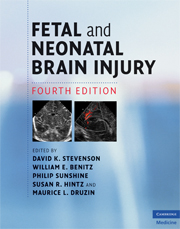Book contents
- Frontmatter
- Contents
- List of contributors
- Foreword
- Preface
- Section 1 Epidemiology, pathophysiology, and pathogenesis of fetal and neonatal brain injury
- Section 2 Pregnancy, labor, and delivery complications causing brain injury
- Section 3 Diagnosis of the infant with brain injury
- 16 Clinical manifestations of hypoxic–ischemic encephalopathy
- 17 The use of EEG in assessing acute and chronic brain damage in the newborn
- 18 Neuroimaging in the evaluation of pattern and timing of fetal and neonatal brain abnormalities
- 19 Light-based functional assessment of the brain
- 20 Placental pathology and the etiology of fetal and neonatal brain injury
- 21 Correlations of clinical, laboratory, imaging, and placental findings as to the timing of asphyxial events
- Section 4 Specific conditions associated with fetal and neonatal brain injury
- Section 5 Management of the depressed or neurologically dysfunctional neonate
- Section 6 Assessing outcome of the brain-injured infant
- Index
- Plate section
- References
18 - Neuroimaging in the evaluation of pattern and timing of fetal and neonatal brain abnormalities
from Section 3 - Diagnosis of the infant with brain injury
Published online by Cambridge University Press: 12 January 2010
- Frontmatter
- Contents
- List of contributors
- Foreword
- Preface
- Section 1 Epidemiology, pathophysiology, and pathogenesis of fetal and neonatal brain injury
- Section 2 Pregnancy, labor, and delivery complications causing brain injury
- Section 3 Diagnosis of the infant with brain injury
- 16 Clinical manifestations of hypoxic–ischemic encephalopathy
- 17 The use of EEG in assessing acute and chronic brain damage in the newborn
- 18 Neuroimaging in the evaluation of pattern and timing of fetal and neonatal brain abnormalities
- 19 Light-based functional assessment of the brain
- 20 Placental pathology and the etiology of fetal and neonatal brain injury
- 21 Correlations of clinical, laboratory, imaging, and placental findings as to the timing of asphyxial events
- Section 4 Specific conditions associated with fetal and neonatal brain injury
- Section 5 Management of the depressed or neurologically dysfunctional neonate
- Section 6 Assessing outcome of the brain-injured infant
- Index
- Plate section
- References
Summary
Introduction
In this updated review, current and advanced neuroimaging technologies are discussed, along with the basic principles of imaging diagnosis and guidelines for utilization in fetal, perinatal, and neonatal brain abnormalities. This includes pattern of injury and timing issues, with special emphasis on neurovascular disease and the differential diagnosis. In the causative differentiation of static encephalopathies (e.g., cerebral palsy, CP) from progressive encephalopathies, specific categories and timing are addressed. These include developmental abnormalities, trauma, neurovascular disease, infections and inflammatory processes, and metabolic disorders. Although a rare but important cause of progressive perinatal encephalopathy, neoplastic processes are not considered in detail here. Molecular and genetic technologies continue to advance toward eventual clinical application.
Neuroimaging technologies and general utilization
Imaging modalities may be classified as structural or functional. Structural imaging modalities provide spatial resolution based primarily on anatomic or morphologic data. Functional imaging modalities provide spatial resolution based upon physiologic, chemical, or metabolic data. Some modalities may actually be considered to provide both structural and functional information.
Ultrasonography (US) is primarily a structural imaging modality with some functional capabilities (e.g., Doppler: Fig. 18.1a,b) [1–8,13–26]. It is readily accessible, portable, fast, real-time and multiplanar. It is less expensive than other cross-sectional modalities and relatively non-invasive (non-ionizing radiation). It requires no contrast agent and infrequently needs patient sedation.
- Type
- Chapter
- Information
- Fetal and Neonatal Brain Injury , pp. 209 - 231Publisher: Cambridge University PressPrint publication year: 2009



